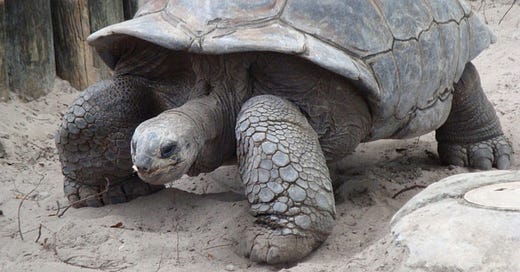10 Things Civil Servants Need to Learn from Tortoises
We re-visit our old article in the new context and relearn the same lesson.
Ten Things Civil Servants Need to Learn from Tortoises
The IAS has been in the news recently for reasons both good and bad. From the controversy over lateral entry, entangled with the absence of any reservation for SC/ST, and the subsequent withdrawal of the advertisement by the UPSC, to a few notorious cases where candidates turned the manipulation of disability certificates into a fine art, engineering a backdoor entry into the prestigious service. Amidst these controversies, many aspiring candidates have reached out to me, seeking to determine whether it is worth their time to make a serious attempt, given these significant aberrations—real or perceived—in the selection process.
It is in this context that I decided to share my previous article on how civil servants—including those who aspire to be—could draw inspiration from tortoises. In the grand tapestry of public administration—now rebranded as good governance—where the urgency of action meets the deliberate pace of careful planning, the Indian Administrative Service (IAS) stands as a testament to the virtues of patience and perseverance. Yet, in a lighter vein, one might argue that our esteemed civil servants could benefit from learning a thing or two from the venerable tortoise, nature's very own bureaucrat. Here, then, are ten tongue-in-cheek lessons for the modern civil servant, drawn from the life and times of these shelled sages.
Slow and Steady, Inch Forward Slowly: The hallmark of both the tortoise and the model civil servant. In an age of rapid change, there’s wisdom in not rushing into rash and reckless decisions. After all, it’s the tortoise that wins the race, not the hare with a penchant for hasty PowerPoint presentations.
Do Not Stick Your Neck Out: A cardinal rule for survival in the bureaucratic jungle. Like the tortoise, a civil servant is well-advised to keep their head down, lest it attract unwanted attention or, heaven forbid, additional responsibilities. Avoid undue risks— stand corrected, avoid any risks.
Be Amphibious, Capable of Surviving in Both Types of Habitats: Just as a tortoise thrives both on land and in water, a civil servant must navigate the murky waters of politics and the dry deserts of policy with equal ease. The capability to get along with politicians of all colours and hues.
Sport Heavy Back-Armour to Prevent Back-Stabbing: In the labyrinthine corridors of power, a metaphorical shell provides essential protection against the slings and arrows of outrageous fortune, or at least those of colleagues.
Maintain a Low Profile: The lower the profile, the less likely it is to be clipped. A tortoise rarely finds itself the subject of controversy, primarily because it’s hard to scandalise something that’s usually mistaken for a rock.
Merge with the Landscape; Don’t Stand Out: In a field where visibility often equates to vulnerability, the ability to blend into the bureaucratic background is a prized skill, much like the tortoise’s knack for camouflaging itself as a particularly uninteresting boulder.
Appear Non-Threatening: Much like our shelled friends, a civil servant should project an aura of benign harmlessness. This makes it easier to advance one’s agenda without alarming the wildlife.
Publicise That You Are a Vegetarian: A vegetarian tortoise offends no one and, similarly, a civil servant who avoids devouring the resources of others will find themselves well-regarded by their peers and the public alike.
Be a Part of the “Creep” but Don’t Be a Creep: While it’s important to move with the collective, maintaining one’s dignity and respectability is crucial. No one likes a creep, whether it’s in the forest or the office.
Hint at the Presence of Galápagos Within the Family: Lastly, suggesting a lineage that traces back to the Galápagos lends an air of mystery and evolutionarily proven resilience. For a civil servant, implying a connection to these ancient survivors— read retired civil servants of some vintage— might just lend the necessary gravitas to survive the budget meetings.
Summing Up
In jest, we find truths wrapped in laughter. The parallels drawn here, between the civil servants of the IAS and the tortoises of the animal kingdom, serve to highlight the virtues of patience, resilience, and adaptability. As we chuckle at the notion of bureaucrats modelling themselves after tortoises, let's not forget the underlying wisdom in taking life one slow, deliberate step at a time. After all, in the race to build a better nation, it might just be the tortoise-like civil servants who, through their steady and undramatic progress, make the most lasting impact1.
Let's illustrate an IAS officer’s career, using 1.05, 1, and 0.95 raised to the power of 35, signifying the number of years of service. This will illustrate an even more dramatic effect of compound growth and decline over time.
1.05^35 = 5.5160 (rounded to 4 decimal places)
1^35 = 1
0.95^35 = 0.1652 (rounded to 4 decimal places)
Interpretation of Results
1.05^35 (5.5160): This represents a 5% improvement each year for 35 years. The result shows that you end up with about 451.60% more than you started with.
1^35 (1): This represents no change year over year. After 35 years, you're exactly where you started.
0.95^35 (0.1652): This represents a 5% decline each year for 35 years. The result shows that you end up with about 83.48% less than you started with.
The Power of Consistent Growth or Decline
These calculations dramatically illustrate the long-term effects of consistent growth or decline:
A 5% improvement each year results in a 451.60% increase over 35 years. You end up with more than 5.5 times what you started with!
Staying the same (1^35) yields no growth.
A 5% decline each year results in a drastic 83.48% decrease over 35 years. You're left with less than 17% of what you started with.
Key Takeaways
Compound Growth: The power of compound growth is evident. A consistent 5% improvement leads to exponential gains over time.
Significance of Small Changes: This example shows how what might seem like small changes (5% up or down) can lead to drastically different outcomes over time.
Importance of Consistency: The compounding effect works both ways. Consistent improvement leads to significant gains, while consistent decline can be devastating.
Long-Term Perspective: These results emphasize the importance of taking a long-term view in personal development, business strategies, or investment decisions.
Resilience Against Decline: The stark difference between growth and decline underscores the importance of not just aiming for improvement, but also actively working to prevent decline.
This illustration powerfully demonstrates why setting goals for continuous improvement—much like a tortoise— even if they seem small, can lead to remarkable results over time. It also shows the importance of addressing and reversing negative trends early, as their long-term effects can be severe.









……the lower level bureaucracy working under the IAS Officers acts like an hard shell of tortoise…..but for general public, At least lower level police administration under the IPS Officers & IPS officers themselves, should be kept away from the concept of tortoise if justice is to prevail in society……